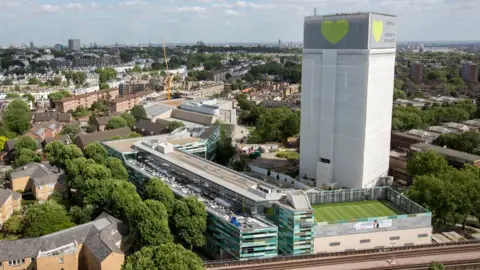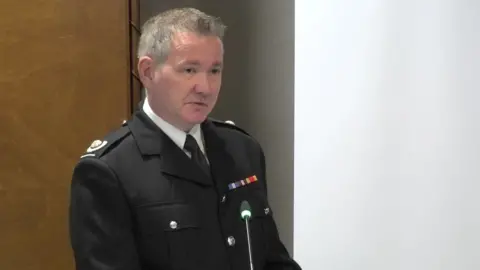Grenfell Inquiry: No-one should have lived there, says fire chief
 PA
PAThe spread of fire inside Grenfell Tower was so horrendous that no-one should ever have been allowed to live there, a fire chief has said.
Deputy assistant commissioner Andrew O'Loughlin told the inquiry into the disaster that the failure of the building could not have been foreseen.
He was defending the decision to tell residents to remain in their homes.
People in flats not yet reached by smoke and fire should have been protected by the building, he said.
Mr O'Loughlin was the most senior London Fire Brigade Officer on the scene and was in charge of the incident when the advice to "stay put" was given to residents.
After 02:47 BST, residents were encouraged to escape if they could, rather than await rescue.
But the commissioner said that firefighters had reason to expect that the "stay put" advice would keep residents safe.
He said: "You wouldn't expect fire to spread around the building like it did on the outside. And for it to fail so catastrophically - we'd never expected or anticipated that.
"We would not expect the internal protection to fail so badly as well. So my expectation was people who were safe in their flats should stay safe in their flats."

One firefighter told the inquiry earlier that the advice for unaffected residents to stay put was redundant by about 01:50.
But Mr O'Loughlin rejected suggestions that the advice should have changed earlier, arguing that the spread of the fire was something that "none of us could ever have expected."
"The building was so horrendous several hours later that I think no-one should have lived in the building," he said.
The inquiry also heard from assistant commissioner Andrew Roe, who described what he believed were failings in the facade and the internal compartments that were meant to prevent fire spreading.
Mr Roe, who arrived on the scene at 02:29, said he was able "to look laterally through the building, I could see right through compartments and see that flame spread."
He said: "The fact the facade had kind of acted as the petrol, as it were, to spread the fire all over the building was one thing, that was obviously genuinely shocking, but it was the complete failure of the building system that caught me by surprise."
The inquiry heard that it took 25 minutes before Mr O'Loughlin was informed that the advice to residents to stay put had been abandoned at 02:47.
Mr O'Loughlin said he was confused by the change and did not think it would necessarily make much difference to residents already trapped inside their flats.
"The change to 'stay put' is, if people feel they can escape then they should try to, but I don't think it's trying to tell people they should go into a smoke-filled environment," he said.
Communicating the change to residents was also "not easily done" as there was no mechanism for contacting each flat in the west London tower block, he added.
The blaze on June 14 2017 caused the deaths of 72 residents.
